Innovative Evaluation Techniques for Hanok Sustainability Based on Integrative Comfort Indices
Abstract
1. Introduction
2. Materials and Methods
2.1. Criteria forEevaluating the Quality of Housing
2.2. Evaluation of the Comfort Performance of Hanok
- Absolute Humidity Difference= 0.33 − 0.239 × Summer Season Survey Average Score (p-value < 0.001)
- Absolute Humidity Difference= 1.128 − 1.215 × Survey Average Score (p-value < 0.001)
- Thermal Resistance Satisfaction Rate by Region (%)= 69.7 + 2.154 × Survey Average Score (p-value < 0.001)
2.3. Questionnaire Composition
- Short and concise questions;
- Avoiding the use of academic jargon or difficult words;
- Avoiding duplicate responses;
- Preventing respondents from being bored;
- Arranging questions logically and probably;
- Intuitive response induction;
- Quantification of data that could be used statistically.
2.4. On-Site Evaluation
3. Results
3.1. Physical Measurements
3.2. Sensory Evaluation
3.3. Comparisions
4. Discussion; Innovation in Hanok, and Open Innovation
5. Conclusions
Author Contributions
Funding
Institutional Review Board Statement
Informed Consent Statement
Data Availability Statement
Acknowledgments
Conflicts of Interest
References
- Kwon, Y.-G. Discussion of Globalization and Cultural Identity. Ind. Des. 1995, 138, 2–8. [Google Scholar]
- Kim, Y.-G. The Theory of the Native Design; Design Net: Gyeonggi-do, Korea, 2000. [Google Scholar]
- Oliver, P. Built to Meet Needs: Cultural Issues in Vernacular Architecture; Architectural Press: Oxford, UK, 2006. [Google Scholar]
- Ghisleni, C. Examples of Vernacular Housing. Available online: https://www.archdaily.com/951667/what-is-vernacular-architecture (accessed on 3 October 2021).
- Rodofsky, B. Architecture without Architects; University of New Mexico Press: Santa Fe, NM, USA, 1964. [Google Scholar]
- Nash, C. Contemporary Vernacular Design: How British Housing Can Rediscover Its Soul; RIBA Publishing: London, UK, 2016. [Google Scholar]
- Atroshenko, V.I.; Grundy, M. Mediterranean Vernacular: A Vanishing Architectural Tradition; Rizzoli: New York, NY, USA, 1991. [Google Scholar]
- Jeong, Y.-B. Understanding Hanok and Its Story; Munundang: Seoul, Korea, 2016. [Google Scholar]
- Hanok Space Research Association. Space Culture of Hanok; Kyomunsa: Seoul, Korea, 2004. [Google Scholar]
- Park, M.-D. Hanok; Salim: Seoul, Korea, 2005. [Google Scholar]
- Jaffari, S.D.; Matthews, B. From occupying to inhabiting—A change in conceptualizing comfort. In IOP Conference Series: Earth and Environmental Science; IOP Publishing: Bristol, UK, 2009; Available online: http://iopscience.iop.org (accessed on 28 September 2021).
- Godoy-Vaca, L.; Vallejo-Coral, E.C.; Martínez-Gómez, J.; Orozco, M.; Villacreses, G. Predicted Medium Vote Thermal Comfort Analysis Applying Energy Simulations with Phase Change Materials for Very Hot-Humid Climates in Social Housing in Ecuador. Sustainability 2021, 13, 1257. [Google Scholar] [CrossRef]
- Beltrán, R.D.; Martínez-Gómez, J. Analysis of Phase Change Materials (PCM) for Building Wallboards Based on the Effect of Environment. J. Build. Eng. 2019, 24, 1–7. [Google Scholar] [CrossRef]
- Raporort, A. House Form and Culture; Prentice-Hall Inc.: Englewood Cliffs, NJ, USA, 1969. [Google Scholar]
- World Health Organization. The Work of WHO, 1961: Annual Report of the Director-General to the World Health Assembly and to the United Nations Covering the Period 1 October–31 December 1961; World Health Organization: Geneva, Switzerland, 1962. [Google Scholar]
- Organization for Economic Cooperation and Development. Compendium of OECD Well-Being Indicators: Housing 2011. Available online: https://www.oecd.org/sdd/47918045.pdf (accessed on 18 March 2021).
- The City and County of San Francisco. Housing Code 2019 Edition; American Legal Publishing Corporation: Cincinnati, OH, USA, 2020. [Google Scholar]
- Korean Agency for Technology and Standards. Korean Industrial Standards. Available online: https://www.standard.go.kr/KSCI/ (accessed on 18 March 2021).
- Lee, M.-H.; Cheon, D.-Y.; Han, S.-H. A Technical Assessment of Comfort Performance of Hanok Using Comparative Field Surveys between Experts and Users. Sustainability 2020, 12, 10315. [Google Scholar] [CrossRef]
- Baron, R.M.; Kenny, D.A. The Moderator–Mediator Variable Distinction in Social Psychological Research: Conceptual, Strategic, and Statistical Considerations. J. Personal. Soc. Psychol. 1986, 51, 1173–1182. [Google Scholar] [CrossRef]
- Jones, L.V.; Peryam, D.R.; Thurstone, L.L. Development of a Scale for Measuring Soldier’s Food Preferences. J. Food Sci. 1955, 20, 512–520. [Google Scholar] [CrossRef]
- Lim, J. Hedonic Scaling: A Review of Methods and Theory. Food Qual. Prefer. 2011, 22, 733–747. [Google Scholar] [CrossRef]
- Lawless, H.T.; Heymann, H. Sensory Evaluation of Food: Principles and Practices; Springer: Berlin/Heidelberg, Germany, 2010. [Google Scholar]
- Newsham, G.; Veitch, J. Cost-Effective Open-Plan Environments Project (COPE); National Research Council (NRC): Ottawa, ON, Canada, 2009. [Google Scholar]
- Preiser, W. Learning from Our Buildings: A State-of-the-Practice Summary of Post-Occupancy Evaluation; National Academies Press: Ottawa, ON, Canada, 2002; Volume 145. [Google Scholar]
- Choi, J.-H.; Loftness, V.; Aziz, A. Post-occupancy Evaluation of 20 Office Buildings as Basis for Future IEQ Standards and Guidelines. Energy Build. 2012, 46, 167–175. [Google Scholar] [CrossRef]
- Creswell, J.W. Research Design: Qualitative. Quantitative, and Mixed Methods Approaches; SAGE Publications: New York, NY, USA, 2013. [Google Scholar]
- Michell, J. An Introduction to the Logic of Psychological Measurement; Lawrence Erlbaum Associates Inc.: Mahwah, NJ, USA, 1990. [Google Scholar]
- Bartlett, R.J. Measurement in Psychology. Adv. Sci. 1940, 1, 422–441. [Google Scholar] [CrossRef][Green Version]
- Stevens, S.S. On the Theory of Scales of Measurement. Science 1946, 103, 677–680. [Google Scholar] [CrossRef]
- Knapp, T.R. Treating Ordinal Scales as Interval Scales: An Attempt to Resolve the Controversy. Nurs. Res. 1990, 39, 121–123. [Google Scholar] [CrossRef]
- Peeters, M.J. Measuring Rater Judgments within Learning Assessments, Part 1: Why the Number of Categories Matter in a Rating Scale. Curr. Pharm. Teach. Learn. 2015, 7, 656–661. [Google Scholar] [CrossRef]
- Borg, G. A Category Scale with Ratio Properties for Intermodal and Inter-Individual Comparisons: Psychophysical Judgment and the Process of Perception; North-Holland Publishing Company: Amsterdam, The Netherlands, 1982; pp. 25–34. [Google Scholar]
- Luce, R.D.; Krumhansl, C.L. Measurement, Scaling, and Psychophysics: Steven’s Handbook of Experimental Psychology; John Wiley & Sons, Inc.: Hoboken, NJ, USA, 1988; pp. 3–73. [Google Scholar]
- Lawless, H.T. Contextual Effect in Category Ratings. J. Test. Eval. 1983, 11, 346–349. [Google Scholar]
- Frank, R.A.; Klaauw, N.J.; Schifferstein, H.N. Both Perceptual and Conceptual Factors Influence Taste-Odor and Taste-Taste Interactions. Percept. Psychophys. 1984, 54, 343–353. [Google Scholar] [CrossRef]
- Diamond, J.; Lawless, H.T. Context Effects and Reference Standards with Magnitude Estimation and the Labeled Magnitude Scale. J. Sens. Stud. 2001, 16, 1–10. [Google Scholar] [CrossRef]
- DeVellis, R.F. Scale Development: Theory and Applications; SAGE Publications: New York, NY, USA, 2003. [Google Scholar]
- Philipp, D. Semantic Network Analysis as a Method for Visual Text Analytics. Procedia Soc. Behav. Sci. 2013, 79, 4–17. [Google Scholar]
- Nagamachi, M. Kansei Engineering: A New Ergonomic Consumer-Oriented Technology for Product Development. Int. J. Ind. Ergon. 1995, 15, 3–11. [Google Scholar] [CrossRef]
- Kiyoshi, F.; Hiroshi, K.; Yoshihisa, F.; Hirokazu, G. Human Sensory Perception Oriented Image Processing in a Color Copy System. Int. J. Ind. Ergon. 1995, 15, 63–74. [Google Scholar]
- National Centers for Environmental Information. Assessing the Global Climate in October 2021. Available online: https://www.ncei.noaa.gov/news/global-climate-202110 (accessed on 22 March 2021).
- Fanger, P.O. Thermal Comfort: Analysis and Applications in Environmental Engineering; Danish Technical Press: Copenhagen, Denmark, 1970. [Google Scholar]
- Kim, J.; Cho, A. Analysis of a structure between comfort feeling and sensibility in indoor environment by using fuzzy inference. In Proceedings of the Korean Society for Emotion and Sensibility Conference, Incheon, Korea, 11 April 1998; Korean Society for Emotion and Sensibility: Daejeon, Korea, 1998; pp. 121–126. [Google Scholar]
- International Standard Organization. Moderate Thermal Environments: Determination of the PMV and PPD Indices and Specification of the Conditions for Thermal Comfort; International Organization for Standardization: Geneva, Switzerland, 1984. [Google Scholar]
- Lee, M.H. Implementation of an Evaluation Model for the Habitability Performance of Hanok. Ph.D. Thesis, Chonnam National University, Kwangju, Korea, April 2019. [Google Scholar]
- Lee, J.; Park, J. Phase Change Material (PCM) Application in a Modernized Korean Traditional House (Hanok). Sustainability 2018, 10, 948. [Google Scholar] [CrossRef]
- Kim, G.-E.; Lee, J.-R. The Impact of Historic Building Preservation in Urban Economics: Focusing on Accommodation Prices in Jeonju Hanok Village, South Korea. Sustainability 2020, 12, 5005. [Google Scholar] [CrossRef]
- Jeong, J.-H.; Cheon, D.-Y.; Han, S.-H. A Better Maintenance Strategy, a More Sustainable Hanok: Towards Korean Traditional Public Facilities. Buildings 2019, 9, 11. [Google Scholar] [CrossRef]
- Han, S.-H.; Lee, M.-H.; Cheon, D.-Y. Assessment Indexes for Habitability Performances Applicable to Hanok Focused on Household Types. KIEAE J. 2018, 18, 5–14. [Google Scholar]
- Robbins, P. From Design Thinking to Art Thinking with an Open Innovation Perspective—A Case Study of How Art Thinking Rescued a Cultural Institution in Dublin. J. Open Innov. Technol. Mark. Complex. 2018, 4, 57. [Google Scholar] [CrossRef]
- Ryu, D.; Baek, K.H.; Yoon, J. Open Innovation with Relational Capital, Technological Innovation Capital, and International Performance in SMEs. Sustainability 2021, 13, 3418. [Google Scholar] [CrossRef]

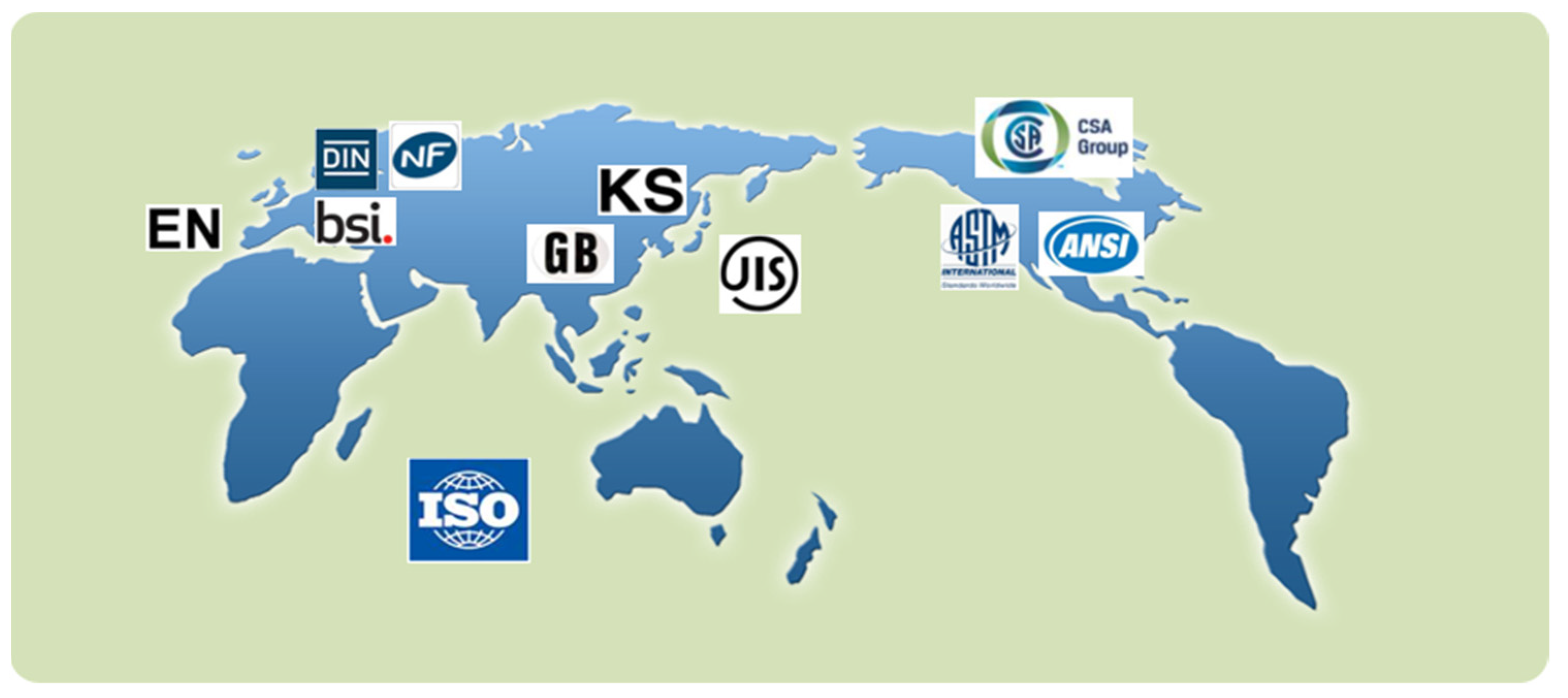


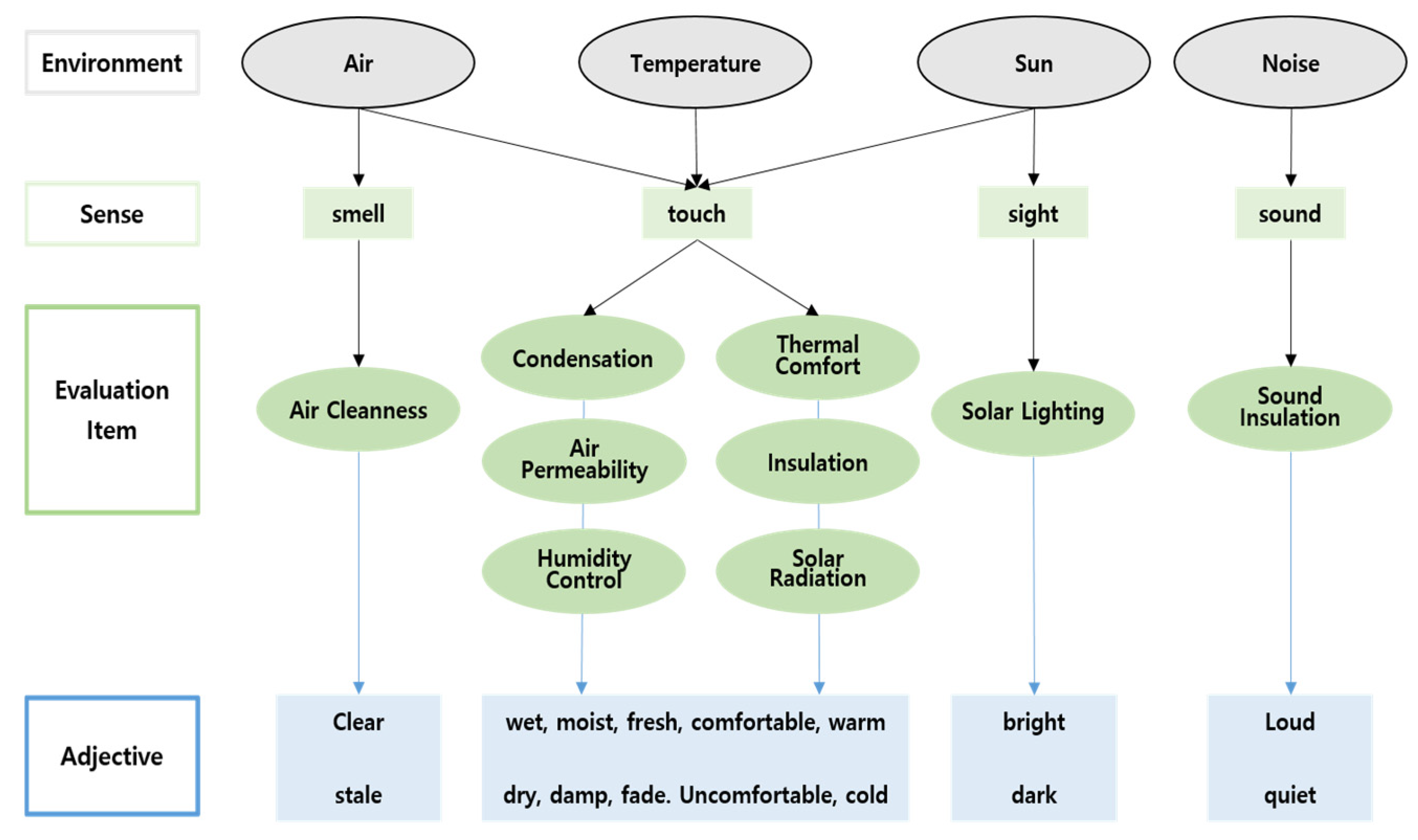
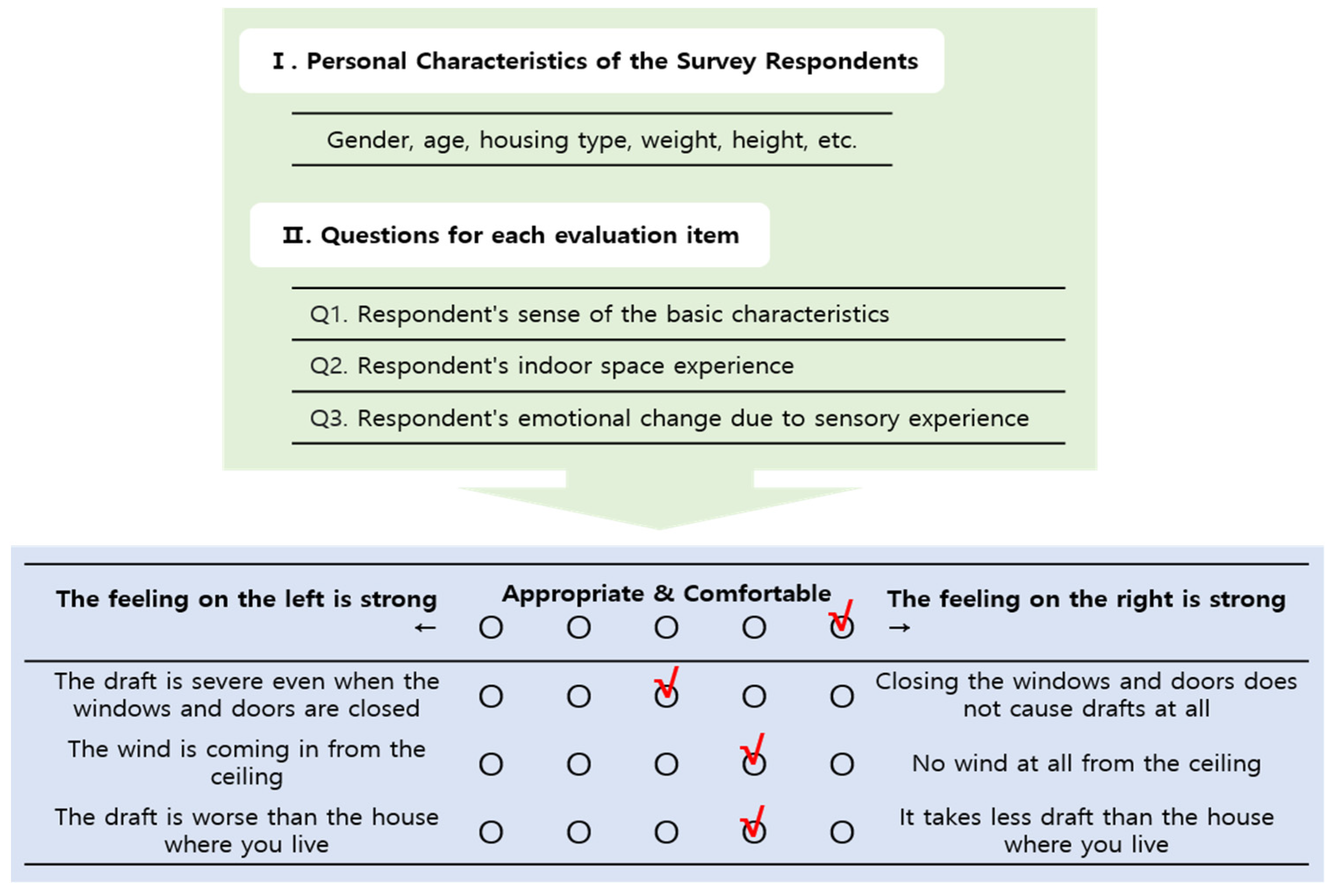

| Evaluation Period | A Comparative Case | |
|---|---|---|
| Difference of Humidity | Difference of Survey | |
| Summer |  | 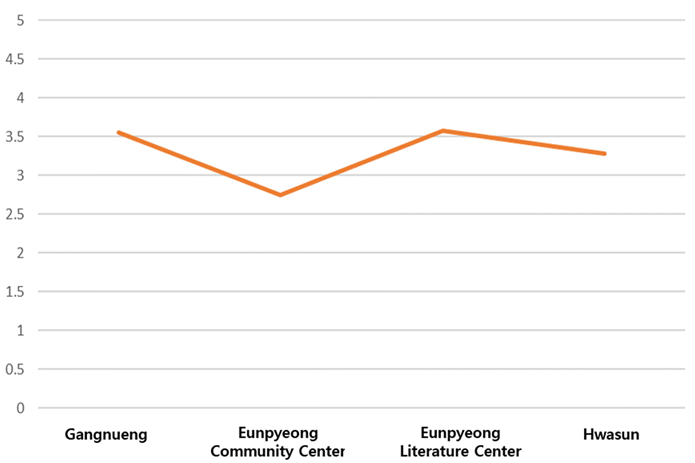 |
| Inter-season |  | 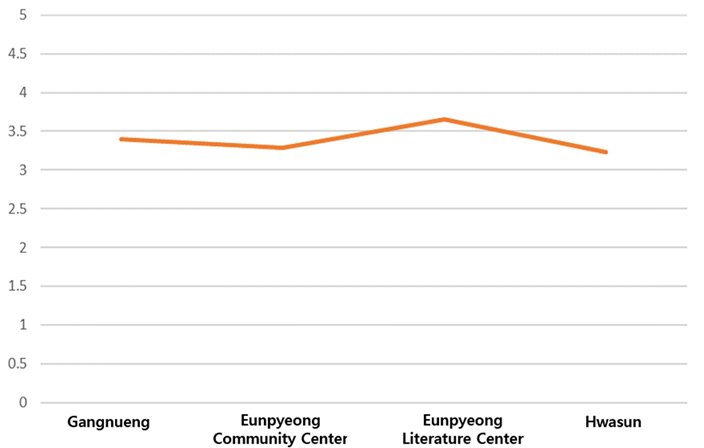 |
| Winter |  |  |
| Evaluation Period | Satisfaction Rate of Thermal Resistance and Survey |
|---|---|
| Summer |  |
| Inter-season |  |
| Winter |  |
 |
| Evaluation Item | Physical Perceptive Factors |
|---|---|
| Measure Value through Final Test Method | |
| Humidity Control | The difference in average absolute humidity between indoor and outdoor air (g/kg DA) |
| Air Permeability | Average airflow speed (m/s) |
| Air Cleanness | Average HCHO concentration in air (µg/m3) |
| Condensation | Temperature difference ratio (TDR) |
| Insulation | Heat transmission rate (W/m2 k) |
| Solar Radiation | Average inflow insolation (Wh/m2) |
| Thermal Comfort | Average PMV value based on clo 0.7, met 1.2 |
| Sound Insulation | Average noise by distance with window closure (dB A) |
| Solar Lighting | Satisfaction area ratio according to LEED v.4 standard (%) |
| Evaluation Item | Physical Perceptive-Factors | |||||
|---|---|---|---|---|---|---|
| Gangneung | Hwasun | |||||
| Summer | Inter-Season | Winter | Summer | Inter-Season | Winter | |
| Humidity Control | −3.9317 | 1.4235 | 1.0847 | −0.5891 | 0.7560 | 1.3941 |
| Air Permeability | 0.09 | 0.02 | 0.02 | 0.07 | 0.03 | 0.03 |
| Air Cleanness | 0.0637 | 0 | 0 | 0.185 | 0.007 | 0 |
| Condensation | - | 0.18 | 0.19 | 0.26 | 0.29 | 0.29 |
| Insulation | Wall 0.341, Roof 0.188, Floor 0.164 | Wall 0.443, Roof 0.662, Floor 0.464 | ||||
| Solar Radiation | 66.07 | 174.79 | 85.31 | 71.52 | 297.06 | 262.24 |
| Thermal Comfort | 0.1 | −0.73 | −0.23 | 1.24 | 0.21 | −1.31 |
| Sound Insulation | - | 35 | 35.65 | - | 32.85 | 30.975 |
| Solar Lighting | 55.7 | 48.26 | 42.7 | 44.88 | 48.37 | 36.77 |
| Target Hanok | Result of Seasonal Survey | ||||||||
|---|---|---|---|---|---|---|---|---|---|
| Gangneung | 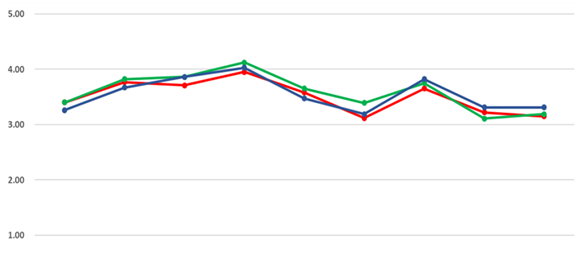 | ||||||||
| Hwasun | 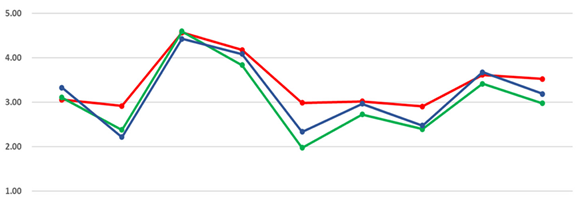 | ||||||||
| Humidity Control | Air Permeability | Air Cleanness | Condensation | Insulation | Solar Radiation | Thermal Comfort | Sound Insulation | Solar Lighting | |
 | |||||||||
| Number | Survey Results in Summer | ||||||||
|---|---|---|---|---|---|---|---|---|---|
| Q1 |  | ||||||||
| Q2 |  | ||||||||
| Q3 |  | ||||||||
| Humidity Control | Air Permeability | Air Cleanness | Condensation | Insulation | Solar Radiation | Thermal Comfort | Sound Insulation | Solar Lighting | |
 | |||||||||
| Number | Survey Results in Summer | ||||||||
|---|---|---|---|---|---|---|---|---|---|
| Q1 |  | ||||||||
| Q2 |  | ||||||||
| Q3 |  | ||||||||
| Humidity Control | Air Permeability | Air Cleanness | Condensation | Insulation | Solar Radiation | Thermal Comfort | Sound Insulation | Solar Lighting | |
 | |||||||||
| Number | Survey Results in Summer | ||||||||
|---|---|---|---|---|---|---|---|---|---|
| Q1 |  | ||||||||
| Q2 |  | ||||||||
| Q3 |  | ||||||||
| Humidity Control | Air Permeability | Air Cleanness | Condensation | Insulation | Solar Radiation | Thermal Comfort | Sound Insulation | Solar Lighting | |
 | |||||||||
Publisher’s Note: MDPI stays neutral with regard to jurisdictional claims in published maps and institutional affiliations. |
© 2021 by the authors. Licensee MDPI, Basel, Switzerland. This article is an open access article distributed under the terms and conditions of the Creative Commons Attribution (CC BY) license (https://creativecommons.org/licenses/by/4.0/).
Share and Cite
Lee, M.-H.; Han, S.-H. Innovative Evaluation Techniques for Hanok Sustainability Based on Integrative Comfort Indices. J. Open Innov. Technol. Mark. Complex. 2021, 7, 244. https://doi.org/10.3390/joitmc7040244
Lee M-H, Han S-H. Innovative Evaluation Techniques for Hanok Sustainability Based on Integrative Comfort Indices. Journal of Open Innovation: Technology, Market, and Complexity. 2021; 7(4):244. https://doi.org/10.3390/joitmc7040244
Chicago/Turabian StyleLee, Mi-Hyang, and Seung-Hoon Han. 2021. "Innovative Evaluation Techniques for Hanok Sustainability Based on Integrative Comfort Indices" Journal of Open Innovation: Technology, Market, and Complexity 7, no. 4: 244. https://doi.org/10.3390/joitmc7040244
APA StyleLee, M.-H., & Han, S.-H. (2021). Innovative Evaluation Techniques for Hanok Sustainability Based on Integrative Comfort Indices. Journal of Open Innovation: Technology, Market, and Complexity, 7(4), 244. https://doi.org/10.3390/joitmc7040244





